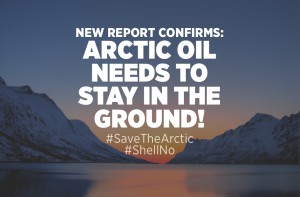When you think of the Arctic, you may picture vast glaciers, frigid waters, miles of ice, and probably the quintessential polar bear. The Arctic has been the final frontier for centuries: the ends of the earth.
But a new reality is setting in in the region – a reality of a changing climate, and the scramble of Big Oil to move in where sea ice is disappearing. But this irony is just the beginning. Royal Dutch Shell is leading the charge in the Alaskan Offshore Arctic, investing billions in a high risk bet that the world will fail to tackle climate change.
In a new report we published today with Greenpeace U.S., we lay bare the case for why the future of Arctic oil is inherently tied to action on climate change. The bottom line is that there is no room for Arctic oil in a climate safe world.
Here are the key reasons why:
– Fossil fuels that have not yet been proven are not burnable in a climate-safe world, given that the vast majority of the fossil fuels we already have access to will need to be left in the ground.
– Industry and government claims that Arctic oil is “needed” are based on oil supply and demand scenarios that will lead to at least 5 degrees Celsius warming by 2100 – i.e. climate disaster.
– The Obama Administration relies on this disastrous scenario ?as its Reference Case for long-term U.S. oil supply and demand planning. Under this scenario, U.S. CO2 emissions would be?190 percent higher than ‘safe’ climate levels in 2040.
– Large investments in Arctic oil are a multi-billion dollar bet that the world will fail to address climate change, and continue hazardous levels of oil use, for decades to come.
– From an investor perspective, U.S. Arctic oil is an asset that has a high risk of becoming stranded as billions are poured into exploration for a resource that ultimately cannot be burned safely.
– U.S. Arctic oil will be exposed to increasing risks associated?with mounting public opposition. These public accountability risks have cost other high carbon industries, such as the Alberta tar sands, billions of dollars, and are the most significant barrier to fossil fuel infrastructure expansion. Concerned citizens are increasingly willing to step up where governments and markets are failing to protect the climate, the environment, and impacted communities.
The fossil fuel industry wants us to believe that oil, gas and coal will continue to dominate our energy supply for decades to come. This fossil fuel fatalism is far from reality, yet it is the basis for flawed policy around the world and a justification for ongoing exploration. It is time to align energy policy with climate science, and start planning for the energy transition everyone knows we must make ?if we are to meet our collective climate goals.
By allowing Shell to drill in the U.S. offshore Arctic Ocean, the Obama Administration is ignoring the world’s best scientists, as well as millions of concerned citizens in North America and beyond. The message is clear: the melting Arctic is a dire warning, not an invitation.
Don’t miss the new report: Untouchable: The climate case against arctic drilling.

I bet that this report is done by the same impeccable researchers that claimed that the oceans would be covering New Jersey by now because of global Warming. Or maybe the same ones that seemed to have miss counted the Spotted Owl and stopped all the logging in the NW.
You can protest all you want, but until we have other alternative fuels that actually work for us and does not cost the average citizen his life savings to acquire and use, then we are stuck with fossil fuels. Get off the oil company’s backs about what MAY happen in the future and and start worrying about the present. Ever go to Aruba and see the pollution happening there and the government doesn’t care? How about China, Russia, Iran. how about those countries that actually murder people who protest pollution in their countries. Get some guts and stop pollution now in a unfriendly country. I know the answer. Those countries don’t allow you in because you either need a haircut, need a job, or are carrying your life in a backpack.